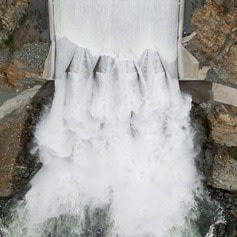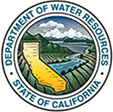 Main Spillway Releases Continue The Department of Water Resources (DWR) continues water releases from Lake Oroville using the main spillway and Hyatt Powerplant. During the winter months, releases from Lake Oroville provide flood protection to downstream communities by maintaining storage capacity in the reservoir for additional rain capture and future snowmelt. DWR coordinates releases closely with the U.S. Army Corps of Engineers and other water operators and adjusts releases as needed to account for continuing runoff. The information below reflects current reservoir level estimates. Forecasts can change quickly and may affect the estimates provided.
Crews may also be seen working near the main spillway for several weeks. Sections of the spillway’s underdrain system are being re-inspected to capture additional video footage. In addition, crews will be performing maintenance and repairs to the spillway’s lighting system. The Lake Oroville reservoir is the largest storage facility in the State Water Project, providing flood protection while supporting environmental and water delivery needs to 27 million Californians. In 2023, Oroville Dam’s main spillway passed over 2,370,000 acre-feet of water, 67 percent of Lake Oroville’s capacity, with flows as high as 36,000 cfs. The main spillway continues to perform well and operate as designed. DWR continues to monitor lake levels, weather forecasts, and mountain snow levels to optimize water storage while allowing for carryover storage into next year.  MARCH SNOW SURVEY DWR conducted the third snow survey of the season at Phillips Station on Feb. 29. The manual survey recorded 47.5 inches of snow depth and a snow water equivalent of 18 inches, which is 77 percent of average for this location. The snow water equivalent measures the amount of water contained in the snowpack and is a key component of DWR’s water supply forecast. Today’s results reflect continued improvement in the snowpack since the slow and dry start to the water year. DWR’s electronic readings from 130 stations placed throughout the state indicate that the statewide snowpack’s snow water equivalent is 18.7 inches, or 80 percent of average for this date, an improvement from just 28 percent of average on Jan. 1. The snowpack is currently only 70 percent of the critical April 1 average, when the snowpack is typically at its peak. An incoming storm is expected to bring several feet of snow to the Sierra Nevada this weekend. More information about the March snow survey may be found in DWR’s press release.  FEATHER RIVER FISH HATCHERY STEELHEAD PLANTING The Feather River Fish Hatchery raised approximately 452,000 yearling steelhead trout around 8.5 to 9.5 inches in length for 2024 releases. Around 7,000 steelhead were released in the Thermalito Afterbay the week of Feb. 12 to support recreational fishing. In addition, 1,011 adult male steelhead were released into the Thermalito Afterbay from December to February after they had been spawned at the hatchery. Hatchery-spawned females were released back to the Feather River. Approximately 445,000 steelhead were released into the Feather River at Boyd’s Pump Boat Launch between Feb. 5 and Feb. 13 to meet mitigation requirements. Releasing the young fish further downstream improves their chances of survival. Like the salmon that populate the Feather River, steelhead trout migrate from the river to the ocean, returning to the river as adults to spawn. Unlike salmon, they can spawn several times during their lifetime. The name “steelhead” comes from their appearance, a more streamlined shape than Chinook salmon with a silvery or brassy color as an adult. The Feather River Fish Hatchery is a California State Water Project (SWP) facility built in the late 1960s to mitigate impacts on fish migration resulting from the construction of Oroville Dam. DWR owns and maintains the facility and provides funding to the California Department of Fish and Wildlife (CDFW) to perform spawning, rearing, and stocking operations. OROVILLE DAM CITIZENS ADVISORY COMMISSION The California Natural Resources Agency hosted its 16th Oroville Dam Citizens Advisory Commission meeting on March 1. In addition to public comment, the Commission received briefings on the process DWR uses to prioritize and select Oroville facility projects, the forecast of expenditures for State Water Project activities at Oroville, and State emergency preparedness coordination and the use of weather forecasting in emergency response. The Citizens Advisory Commission is a forum for questions and feedback from the communities surrounding Oroville Dam. For information on the meeting, please visit the Oroville Dam Citizens Advisory Commission website. A transcript of the meeting will be available on the webpage in the coming weeks.  OROVILLE RECREATION The Lake Oroville Visitor Center is open daily from 9 a.m. to 5 p.m. Staffed by knowledgeable guides, the Visitor Center features interpretive displays on Oroville Dam, area geology, wildlife and habitat, hydroelectric power, and cultural and historical artifacts. View videos in the theater about the construction of Oroville Dam, walk or hike along nearby trails, and visit the 47-foot-tall observation tower that provides unsurpassed panoramic views of surrounding areas. Free guided tours for school and community groups are available by reservation. Parking and admission to the Visitor Center are free. DWR, the California Department of Parks and Recreation (State Parks), and CDFW maintain over 92 miles of trails in the Oroville area. An interactive map of recreation facilities, including open trails and their permitted uses (hike, bike, horse, multi), is available on DWR’s Lake Oroville Recreation webpage. A paper trail map is available at various locations, including most entrance kiosks and the Lake Oroville Visitor Center. Trail users on the Brad Freeman Bike Trail that follows the old railroad grade between downtown Oroville and Hyatt Powerplant have long enjoyed the section of trail through the historic train tunnel. Unfortunately, wire theft and vandalism have rendered the train tunnel’s lighting system inoperable and beyond repair. DWR is designing an entirely new lighting system with construction anticipated in late 2024. The trail will remain open, but users are advised to bring their own light to navigate the train tunnel. Lake Oroville is one of the State Water Project’s premier recreational destinations and one of California’s best fishing spots. The lake provides both warm-water and cold-water fisheries and is a popular destination for bass tournaments. Below the Oroville Dam, the Thermalito Afterbay and the Feather River offer additional excellent fishing opportunities. The marinas at Bidwell Canyon and Lime Saddle are open daily and provide a variety of services including a convenience store, gas, and boat rentals. Upstream migrating fish totals between Jan. 1 and Feb. 25 are:
CURRENT LAKE OPERATIONS Lake Oroville is at 860 feet elevation and storage is approximately 2.95 million acre-feet (MAF), which is 83 percent of its total capacity and 132 percent of the historical average. Feather River flows remain at 3,650 cfs through the City of Oroville with 10,350 cfs being released from the Thermalito Afterbay River Outlet (Outlet) for a total Feather River release of 14,000 cfs downstream. DWR continues to assess releases to the Feather River daily. Visitors to Oroville Dam may also notice minor amounts of water flowing from drains built into the emergency spillway, which is normal and expected with the emergency spillway design. The dam and emergency spillway continue to operate as intended. The public can track precipitation, snow, reservoir levels, and more at the California Data Exchange Center. The Lake Oroville gage station is identified as “ORO.” All data as of midnight 2/29/2024. Comments are closed.
|
Archives
May 2024
Categories
All
|


 RSS Feed
RSS Feed